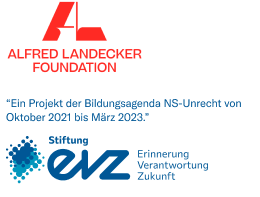Annotations
Breslau
11/21/1941
In the background, a man stands on a pile of luggage overlooking the crowd. In front of him to his right is a municipal officer with a bicycle. On the upper edge of the picture, a truck tarpaulin cuts into the view.
Annotations
Keywords
3
Historical context
Deportation von Breslau nach Kaunas am 25.11.1941
On the instructions of the Gestapo, preparations for the first deportation started in Breslau early in November 1941. Prior to that, Gestapo official Alfred Hampel had travelled to Berlin tasked with closely observing the course and implementation of deportations there and applying the same procedure in Breslau. Together with his colleague Hermann Fey, he was primarily responsible for the implementation of the deportations in Breslau. In the early hours of 21.11.1941, police officers began to pick up about 1,000 people from their homes and take them to the “Schießwerder” restaurant and event venue with beer garden. After spending four days in appalling conditions, the deportees were led to Odertor station on November 25, from where the special train “Da 30” took them to Kaunas. On the very night of their arrival on 29.11.1941, they were forced to march six kilometers to fortress Fort IX, where they were shot by Einsatzkommando 3 of Einsatzgruppe A headed by Karl Jäger.
Sources
About the image series
The series consists of twelve original prints in the format 4x6. Four photos show the Jews gathering with their luggage in the “Schießwerder’s” beer garden in dry weather. Two other photos documenting people’s arrival on the site probably were taken by Albert Hadda on November 21, 1941. He took the pictures from close, shielded by vehicles and buildings. The forecourt in sleet is depicted in six pictures: piles of luggage are lying there or being loaded onto vehicles. In the background of the picture, a crowd of people can be discerned. They were photographed secretly, from the loading area of a vehicle. It is probable that these photos were taken on one of the following days and document how the luggage was loaded for the transport to Odertor station.
Photographer
Albert Hadda, Architekt
Albert Hadda, born in Cosel in 1892, grew up with four siblings in a religious home. He studied architecture in Breslauunder Hans Poelzig. He worked for Walter Gropius in Berlin later. After being banned from their professions in 1934, he and his brothers Moritz (architect) and Siegmund (physician) worked for the Jewish community. Their sister Else and brother Willy emigrated. As a Zionist, Hadda gave courses for migration. He was a skillful photographer and kept his camera – despite the ban. Time and again, he took secret photos Being married to a Christian, he escaped deportation. Moritz was deported to Kaunas in 1941, Siegmund to Theresienstadt in 1943. In 1944, Albert was sent to the Grüntal labor camp, but fled to Breslau. He survived and migrated to Israel joining his daughters there.
Provenance
The twelve pictures and another one documenting the deportation in April 1942 have been preserved in the archives of the “Landesverband Sachsen” (Saxony’s land association) of the Jewish communities in Dresden and discovered in 2023. The original prints were kept in an envelope labeled “Miscellaneous”. It is most probable that the thirteen photos found their way to Erfurt with a group of survivors from Breslau, among them Albert Hadda, in late summer 1945. How they came to Dresden has not finally been clarified. Either Werner Sander handed them in, or they were taken to Dresden as a result of the move of the association of Jewish communities in the GDR in 1962. After 1950, the Ghetto Fighters’ House Memorial in Israel received seven negatives probably photographed by Helmut Eschwege.
Call number at source archive
Ohne Signatur
Title at source archive
Ohne Titel
Acknowledgements
We thank Steffen Heidrich, who has discovered the pictures in the archives of Saxony’s land association of the Jewish communities in Dresden, and the land association for sharing the images. We would also like to thank Katharina Friedla, Maria Luft, Daniel Ljunggren, and Tim Buchen for their valuable advice.
Text and research by Lisa Paduch und Ramona Bräu-Herget.
Kooperationsverbund #LastSeen. Bilder der NS-Deportationen Dr. Alina Bothe Projektleiterin
c/o Selma Stern Zentrum für Jüdische Studien Berlin-Brandenburg
Freie Universität Berlin
Habelschwerdter Allee 34A
14195 Berlin
lastseen@zedat.fu-berlin.de
Ein Kooperationsprojekt von

Gefördert durch

Datenschutz | Impressum